An interesting tour along the historic streets of Bergamo’s hills. This itinerary will allow you to visit different areas of historical and naturalistic interest just a stone's throw from the city. It will give you countless views of the city and the surrounding areas, while pedalling in complete relaxation on quiet roads with little traffic.
The route is completely on asphalt, therefore possible with any bike as long as it has gears so the ascents and short stretches of cobblestones aren’t too challenging.
The tour departs from Bergamo train station where, in the square, you will also find Bergamo’s tourist office. From here you will reach the Astino Valley along cycle paths and low traffic roads.
The Astino Valley is a green hilly area in the city that boasts the former Astino Monastery (open to visitors), a section of the botanical garden called Biodiversity Valley as well as many initiatives and activities that are organised here.
From Astino you will reach the second stop of the tour, San Vigilio, the highest hill in the city, from which you can admire a wonderful panorama and where you can visit the homonymous castle.
Descending from the hill, the last stop will be in the Upper Town, the historic heart of Bergamo. Here you will have to walk your bike, while discovering the city's major monuments and while strolling through the cobbled streets of the historic centre.
Route information:
Departure point: Bergamo train station, piazzale Marconi
Arrival point: Bergamo train station, piazzale Marconi
Travel time: 3 hours
Length: 17km
Type of path: low traffic road 55%, medium traffic road 30%, cycle path 15%
Ground: asphalt: 80%, cobblestones: 20%,
Total change in altitude: 400m
Minimum altitude: 237m
Maximum altitude: 490m
Practicability: All year
Recommended bicycle: any bike that has gears to tackle the ascents and short cobbled sections.
Difficulty: the ascents are difficult at times
Suitable for: Adults with some training.
An interesting tour along the historic streets of Bergamo’s hills. This itinerary will allow you to visit different areas of historical and naturalistic interest just a stone's throw from the city. It will give you countless views of the city and the surrounding areas, while pedalling in complete relaxation on quiet roads with little traffic.
The route is completely on asphalt, therefore possible with any bike as long as it has gears so the ascents and short stretches of cobblestones aren’t too challenging.
The tour departs from Bergamo train station where, in the square, you will also find Bergamo’s tourist office. From here you will reach the Astino Valley along cycle paths and low traffic roads.
The Astino Valley is a green hilly area in the city that boasts the former Astino Monastery (open to visitors), a section of the botanical garden called Biodiversity Valley as well as many initiatives and activities that are organised here.
From Astino you will reach the second stop of the tour, San Vigilio, the highest hill in the city, from which you can admire a wonderful panorama and where you can visit the homonymous castle.
Descending from the hill, the last stop will be in the Upper Town, the historic heart of Bergamo. Here you will have to walk your bike, while discovering the city's major monuments and while strolling through the cobbled streets of the historic centre.
Route information:
Departure point: Bergamo train station, piazzale Marconi
Arrival point: Bergamo train station, piazzale Marconi
Travel time: 3 hours
Length: 17km
Type of path: low traffic road 55%, medium traffic road 30%, cycle path 15%
Ground: asphalt: 80%, cobblestones: 20%,
Total change in altitude: 400m
Minimum altitude: 237m
Maximum altitude: 490m
Practicability: All year
Recommended bicycle: any bike that has gears to tackle the ascents and short cobbled sections.
Difficulty: the ascents are difficult at times
Suitable for: Adults with some training.
From Bergamo train station, ride along Viale Papa Giovanni XXIII (pic1) up to the Porta Nuova Propylaea (entrance gate to the lower city) and, without going through them, turn left into via Tiraboschi (pic2). Continue straight (pic3) (pic4) (pic5) until you get onto the cycle path in the residential area "il Triangolo" (pic6).
Cross via Palma il Vecchio (pic7) and take the stretch of path that, going straight, takes you to the San Paolo neighbourhood (pic8) (pic9) to the parish of Loreto (pic10). Now turn right (pic11) (pic12) where you will go through the residential area of Loreto (pic13) (pic14).
After reaching the beautiful Loreto park go to the right (pic15) and, on via Broseta, again to the right (pic16) for a few metres.
Go left on via Strada Vecchia (pic17), pass next to the door of San Matteo up to the stop sign and then go down to the left along via Longuelo (pic18) (pic19).
At the traffic light turn right (pic20) (pic21), at the fork keep right again (pic22) and here we are in the Astino Valley, near the wonderful Astino Monastery.
From Bergamo train station, ride along Viale Papa Giovanni XXIII (pic1) up to the Porta Nuova Propylaea (entrance gate to the lower city) and, without going through them, turn left into via Tiraboschi (pic2). Continue straight (pic3) (pic4) (pic5) until you get onto the cycle path in the residential area "il Triangolo" (pic6).
Cross via Palma il Vecchio (pic7) and take the stretch of path that, going straight, takes you to the San Paolo neighbourhood (pic8) (pic9) to the parish of Loreto (pic10). Now turn right (pic11) (pic12) where you will go through the residential area of Loreto (pic13) (pic14).
After reaching the beautiful Loreto park go to the right (pic15) and, on via Broseta, again to the right (pic16) for a few metres.
Go left on via Strada Vecchia (pic17), pass next to the door of San Matteo up to the stop sign and then go down to the left along via Longuelo (pic18) (pic19).
At the traffic light turn right (pic20) (pic21), at the fork keep right again (pic22) and here we are in the Astino Valley, near the wonderful Astino Monastery.
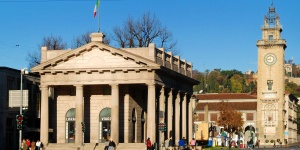
Train is the best way to get to Bergamo: going out of the railway station, you have an immediate and wonderful overview of the city. Your sight follows a straight line going up to Porta Nuova, the heart of the Lower Town. Raise your head just a little bit and your eyes will be filled with the majestic and perfect landscape of the Upper Town.
In 1837, the old wicket gate nestled in the “Muraine”, the massive XV Century walls that used to surround the hills and go down to the Lower Town and the old districts, was replaced by an iron gate opening a breach in the defensive walls: it is Porta Nuova (“New Gate”).
This place represented the main gateway to the commercial area of Bergamo for a very long time. Today, it is still the main junction around which the main streets and monuments of the Lower Town lie.
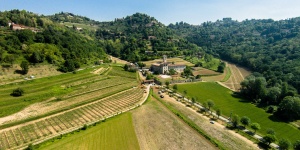
Located between the Bosco dell’Allagrezza (the “Cheerfulness Wood”) and the Benaglia Hill, the Astino Valley immediately conveys a sense of piece and serenity. That’s why in 1170 the vallombrosan monks decided to build their monastery and the Santo Sepolcro here.
A tight boundary was established between these religious buildings and the territory, to the extent that the name “Astino” indicates both the valley and the historical complex. In this little piece of heaven, space and time merge into something eternal.
Sit on the wide meadow surrounding this site: the beauty and the calm of the landscape will amaze you. Forests, hills and fields almost hide the network of streets all around the monastery: eastwards to the district of Longuelo, Bergamo, westward to the San Martino valley, heading north to San Sebastiano and the Bastia and San Vigilio hills.
From the former Astino Monastery continue on the cobbled road uphill and reach Lavanderio, so called because in the past laundresses used to work there for the city’s wealthy families.
Then take the right and, after a hairpin bend, go through the arch that leads you to the entrance of the hamlet on Sudorno hill, where the temple dedicated to those lost during the war is situated.
Turn left into via Torni (pic23) and you will reach Pascolo dei Tedeschi.
Turn right uphill (pic24) and after having taken two hairpin bends (pic25) you are at the small church of San Sebastiano.
Continue your ride taking the road to the left of the church on via Colle dei Roccoli (pic26). During the ascent, turn your gaze towards the area where the Brembo river flows and further north to admire Mount Linzone.
Once you reach an open space where the Alpine troops’ headquarters is located, turn right uphill (pic27), continue along two hairpin bends and once you reach the top you will find yourself on a panoramic terrace with views over the lower city, San Vigilio and, if the sky is clear, Milan’s skyline.
Go down towards the village and continue straight on the road lined with houses and the greenery of their plants (pic28). At the stop sign in the locality of Largo del Pozzo, go straight on (pic29) until you get to the terrace of San Vigilio, another vantage point where you will surely make a small stop to take some pictures.
From the former Astino Monastery continue on the cobbled road uphill and reach Lavanderio, so called because in the past laundresses used to work there for the city’s wealthy families.
Then take the right and, after a hairpin bend, go through the arch that leads you to the entrance of the hamlet on Sudorno hill, where the temple dedicated to those lost during the war is situated.
Turn left into via Torni (pic23) and you will reach Pascolo dei Tedeschi.
Turn right uphill (pic24) and after having taken two hairpin bends (pic25) you are at the small church of San Sebastiano.
Continue your ride taking the road to the left of the church on via Colle dei Roccoli (pic26). During the ascent, turn your gaze towards the area where the Brembo river flows and further north to admire Mount Linzone.
Once you reach an open space where the Alpine troops’ headquarters is located, turn right uphill (pic27), continue along two hairpin bends and once you reach the top you will find yourself on a panoramic terrace with views over the lower city, San Vigilio and, if the sky is clear, Milan’s skyline.
Go down towards the village and continue straight on the road lined with houses and the greenery of their plants (pic28). At the stop sign in the locality of Largo del Pozzo, go straight on (pic29) until you get to the terrace of San Vigilio, another vantage point where you will surely make a small stop to take some pictures.
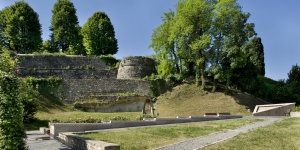
Representing a clearly visible symbol of power, San Vigilio Castle has been the residence of Bergamo’s numerous rulers for centuries. It is located 496 meters above the sea level, on top of the hill that gives it its name, overlooking the Città Alta: that’s why it used to have a strategic role in case of attacks. From its top, you can see the Mount Bastia nearby and the villages of the old Breno valley (called Valbrembo and Paladina today), along with the Almenno plain, also known as Lemine, once renowned for being an important trade centre, and the hamlets located all along the street leading to the Brembana valley. This spectacular and vast landscape also embraces a significant part of the pre-Alps. The circle plan of the building resembles a star, featuring the four towers called Castagneta, Belvedere, Del Ponte and San Vigilio. Its basements are very tortuous: a tunnel (accessible in part) was also found, connecting the Castle directly to the northern side of the hills fortification, inside the San Marco Fortress.
Continue along the road and turn uphill to the left (pic30)
If you wish, take a short detour and go straight ahead, taking the bike a few metres in the wrong direction to reach San Vigilio and the funicular station that comes from the Upper Town. Go left along the road with wonderful views of the upper town and that takes you to the San Vigilio Castle. The castle can be visited but bikes are not allowed.
Turning left on the ascent, you enter on the right onto Via Cavagnis where the descent begins. After four turns you quickly arrive in the square at Colle Aperto, inside the walls of the Upper Town.
Continue along the road and turn uphill to the left (pic30)
If you wish, take a short detour and go straight ahead, taking the bike a few metres in the wrong direction to reach San Vigilio and the funicular station that comes from the Upper Town. Go left along the road with wonderful views of the upper town and that takes you to the San Vigilio Castle. The castle can be visited but bikes are not allowed.
Turning left on the ascent, you enter on the right onto Via Cavagnis where the descent begins. After four turns you quickly arrive in the square at Colle Aperto, inside the walls of the Upper Town.
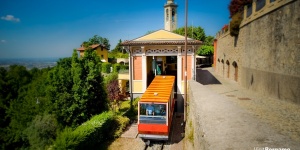
If you have already taken the first funicular and reached Piazza Mercato delle Scarpe in the Upper Town, don’t stop your climb: go and try out the second one, to visit the San Vigilio hill!
This system leads you to a less-popular part of the city, worthy of being visited as it’s surrounded by nature and represents the perfect starting point for a walk across the wonderful “Parco dei Colli –Hills Park”, a protected green area of 4,700 hectares. It was inaugurated on August 27th 1912 and designed by Alessandro Ferretti, one of the best Italian engineers of that time, who planned tens of funicular railways and realized about 15 of them.
San Vigilio funicular covers 630 meters, with a 90 m difference in height and a slope going from 10% to 22%, which lets you enjoy a stunning view of the hills and the plain.
From Largo Colle Aperto continue to the right and ride along Viale delle Mura (pic31), the road follows the course of the historic Venetian walls, Unesco World Heritage, to lead you behind Porta San Giacomo, the white marble gate. Go through it and go out of the walls (pic32) and continue straight on via Sant’Alessandro which descends towards the lower town (pic33).
At the square with the church turn left into via Botta (pic34) and at the traffic light turn right onto viale Vittorio Emanuele II (pic35), an elegant tree-lined avenue that, in a few minutes, will take you straight back to the train station, the point starting point of the tour.
From Largo Colle Aperto continue to the right and ride along Viale delle Mura (pic31), the road follows the course of the historic Venetian walls, Unesco World Heritage, to lead you behind Porta San Giacomo, the white marble gate. Go through it and go out of the walls (pic32) and continue straight on via Sant’Alessandro which descends towards the lower town (pic33).
At the square with the church turn left into via Botta (pic34) and at the traffic light turn right onto viale Vittorio Emanuele II (pic35), an elegant tree-lined avenue that, in a few minutes, will take you straight back to the train station, the point starting point of the tour.
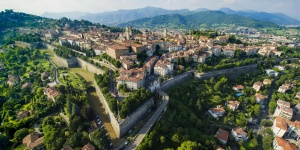
Bergamo wouldn’t be the same without its impressive Venetian Walls. This spectacular circuit is over six km long: it’s the perfect place to take a romantic walk and enjoy wonderful sunsets, and it has been enclosing the beauties of the Upper Town for more than four centuries.
The priceless artistic and cultural value of the Venetian Walls is demonstrated by their recognition as a Unesco World Heritage site.
They were built starting from 1561 by the Republic of Venice in order to face enemies attacks, but History was kind with them: maybe due to their stunning beauty, they never underwent any siege. That is why they remained almost intact to the present day.
The Walls consist of 14 bastions, 2 platforms, 100 embrasures for cannons, 2 armouries, four gates, not to mention the underground structures featuring sallies, passages and tunnels: don’t miss the chance to walk inside the Walls and to visit the casemates of San Michele and San Giovanni!
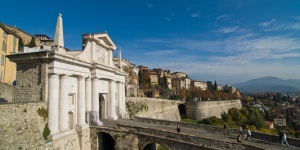
San Giacomo Gate (“Porta San Giacomo”) used to be the entrance to Bergamo for those who came from Milan. It’s the only access to the Walls that can be perfectly seen from Viale Vittorio Emanuele, the axis crossing Lower Bergamo from South to North, both for its position and for its colour. In fact, it is made of white marble extracted from Zandobbio’s quarries, in the near Cavallina Valley: this material makes the gate stand out against the grey defensive walls. Due to these characteristics, besides being one of the most photographed places of Bergamo, it is also an ideal background on which projecting coloured lights during particular events (for instance, the colours of the Italian flag during national celebrations. Lean on the balustrade and enjoy, on one side, a stunning view of the Venetian fortification, and a fantastic panorama of the Lower Town and the Plain up to the Apennines on the other one!
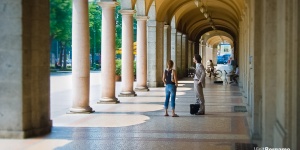
The centre of modern Bergamo is the ideal place to walk in the name of shopping, amusement, art and history!
This ancient and elegant part of the city is called Centro Piacentiniano, an amazing architectural complex that used to host the old city trade fair. This very same atmosphere still enlivens the area, thanks to the numerous markets and events filling the city centre with colours and scents all over the year. Walking along the Sentierone pedestrian way, passing by the imposing chestnut trees and beyond the Porta Nuova propylaea, you will get to via XX Settembre: here you can admire Palazzo Frizzoni, Bergamo’s City Hall.
From here on, enjoy the local life: boutiques, shops, alleys and beautiful small squares, in the name of amusement. Last but not least, how about a good coffee or a drink in one of the numerous cafes and bars?